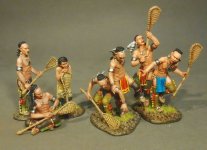THE EIGHTEENTH CENTURY
THE RAID ON ST. FRANCIS 1959
Lacrosse has its origins in a tribal game played by eastern Woodlands Native Americans and by some Plains Indians tribes in what is now Canada.
The game began with the ball being tossed into the air and the two sides rushing to catch it. Because of the large number of players involved, these games generally tended to involve a huge mob of players swarming the ball and slowly moving across the field. Passing the ball was thought of as a trick, and it was seen as cowardly to dodge an opponent.
Lacrosse is one of the oldest team sports in North America. There is evidence that a version of lacrosse originated in what is now Canada as early as the 17th century
Traditional lacrosse games were sometimes major events that could last several days. As many as 100 to 1,000 men from opposing villages or tribes would participate. The games were played in open plains located between the two villages, and the goals could range from 500 yards ,to 6 miles apart!

There are traditionally three areas of scoring on the stickball pole. There is a mark, about chest high on the pole, and when scored above, awards one point. Contact below that point is not scored. The top half of the pole, well above arms reach, is worth two points when hit. The very top of the pole, usually embellished with a large figure of a fish, is worth three points. In recreational games, scoring is loosely kept, most times by the audience or a few players. Games typically reach around twenty points before concluding
Lacrosse traditionally had many different purposes. Some games were played to settle inter-tribal disputes. This function was essential to keeping the Six Nations of the Iroquois together. Lacrosse was also played to toughen young warriors for combat, for recreation, as part of festivals, and for the bets involved.

WIM-09
THE RAID ON ST. FRANCIS 1759,
Woodland Indians,
Youth, Watching Lacrosse Game,
(1pc)
THE PROVINCIAL REGIMENTS
THE SOUTH CAROLINA PROVINCIAL REGIMENT
On July 6, 1757, the South Carolina Provincial Regiment was created by an act of the Assembly. The regiment was to be made up of 7 companies of 100 men each. The regiment was commanded by Lieutenant-colonel Probart Howarth. Howarth, a veteran of Braddock’s campaign, also held a commission as lieutenant in the Independent Companies.
”They have passed a Vote here for granting a Sum for raising 700 Men subject to the Orders & Disposal of Lord Loudoun, have put them on the same Establishment with our Troops, and have given your old Acquaintance Howarth the Command of Them, as Lieut. Colo. & Commandant of the So. Carolina Provincials.” (George Washington Papers (memory.loc.gov/), Captain George Mercer to George Washington, August 17, 1757.)
Each company was led by 1 captain , 2 lieutenants and 1 ensign. Each company also had 4 sergeants, 4 corporals and 2 drummers.
The regiment was also known as the Buffs, due to the facing colour of their uniforms. Men were only recruited with great difficulty, and by mid 1758 the regiment contained only about 550 privates. Attempts were made to fill up the regiment by enlisting vagrants.

RRBSC-05
THE RAID ON ST. FRANCIS 1759,
THE SOUTH CAROLINA PROVINCIAL REGIMENT,
2 Line Infantry Marching,
(2pcs)

RRBSC-05N
THE RAID ON ST. FRANCIS 1759,
THE SOUTH CAROLINA PROVINCIAL REGIMENT,
4 Line Infantry Marching, Set #1,
(4pcs)
More to follow.....................................................





